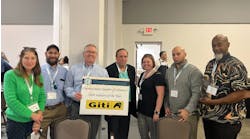Tim Bent, director of environmental affairs for Bridgestone Americas Inc., recently received the President's Award from the Wildlife Habitat Council (WHC). It is only the eighth time someone has received the award in the WHC’s 24-year history.
Bridgestone says Bent received the award for his "outstanding contribution to preserving and protecting the environment for future generations, while leading the commitment of (Bridgestone) and its employees worldwide on projects demonstrating contemporary approaches to environmental stewardship and conservation education at corporate sites worldwide."
Bent’s creative involvement with the Wildlife Habitat Council has been a major factor in wildlife habitat enhancement and conservation education programs at Bridgestone sites throughout the United States. More than 10 Wildlife at WorkSM and Corporate Lands for LearningSM programs are now active at Bridgestone sites.
These programs involve hundreds of company employees and reach more than 6,000 learners.
WHC’s Corporate Wildlife Habitat Certification/International Accreditation Program recognizes commendable wildlife habitat management and environmental education programs at individual sites. WHC certification is designed to add value to programs by providing third-party credibility and an objective evaluation of projects.
The President’s Award was established to recognize individuals at member or partner organizations who have demonstrated leadership in community outreach, conservation education and environmental stewardship.
“Mr. Bent has been a member of the Wildlife Habitat Council Board of Directors since 2007 and, in that capacity, has lead WHC to see and pursue a wide-range of opportunities involving used and marginal lands around corporate facilities to connect people to actions, leading to improved awareness and understanding of the importance of preserving the biological integrity of our earth," says WHC President Robert Johnson.
"Through his efforts, buffer lands, brownfields, RCRA sites and even restored Superfund Sites are now serving as important areas of wildlife release, community conservation education for all age groups and open-space that would have not been achieved without his vision.”


